 print preview
print previewback GEA HAFF
Wynwood Black
Scribe of the Seven Gates
There are gates in our mind, our heart, and the manifest world. There are gates to heaven and gates to hell. To far-flung galaxies and different realities right here on Earth. Ten thousand gates with ten thousand keys. An image can unlock them. An experience. A painting, photograph, a war, or a love. A single word. Even a wall. And all these things can close them too.
There are ten thousand ways to close a gate.
Ten thousand locks with ten thousand keys.
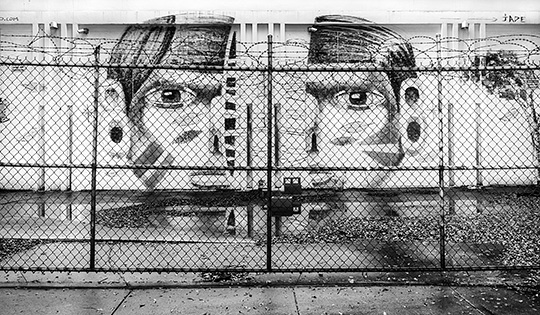 |
Miami is a place of many gates. Wynwood, especially. That’s why I’m here. Wherever there is art there is a gate to somewhere else, and Wynwood has the densest collection of street art in the world. Free for anyone who wishes to come and look. No doors to be buzzed through. No locks. Open even to America’s poorest a few blocks over.
Wynwood is full of walls: some faded, some fresh, some tagged, others revered. Colored walls laid bare beneath the sky for all to see. Walls with words written, images inscribed, symbols sprayed upon their smooth concrete like modern hieroglyphics. And if you squint your eyes beneath the blazing sun, you can see magic shimmering through the heat like fumes of jet fuel wavering in the solar shadows.
Wynwood’s walls are made to be climbed over, slipped through, and written upon. These walls don’t keep you out, they call you in.
They whisper. Open your eyes, slip the veil.
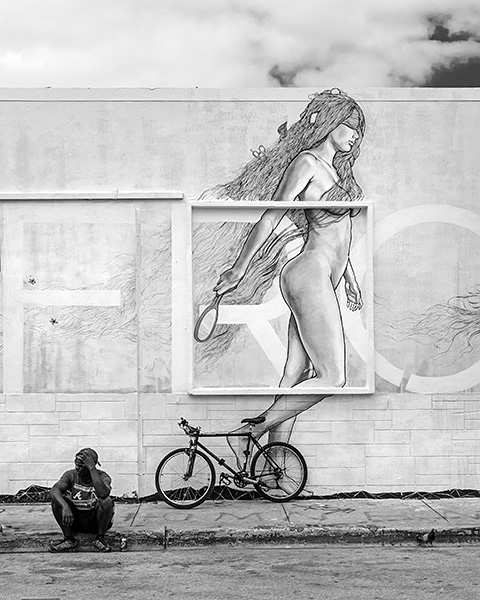 |
They scream. Wake the fuck up, motherfucker!
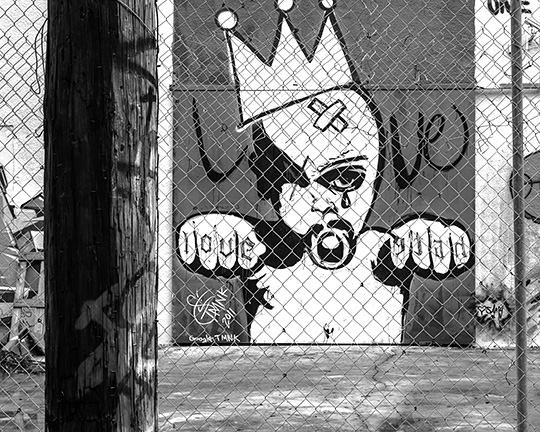 |
Artists come here from all over the world to stake their claim, gate makers all of them, even if they don’t know it. Not trained in the ancient ways as I am, but trained in their own ways, nonetheless. Some train in ghettos, abandoned warehouses, or subway stations. Others learn in schools, private classes, or their own bedrooms pouring over pictures and magazines, filling up blank sheaves of paper with their forms and letters. Words tight as bullets. Sharp as a knife.
All kinds of scribes come to Wynwood. Some lead you nowhere; others take you somewhere. Portals open in your mind. A door cracks ajar. Light leaks in, or darkness. Street writers smash boxes, transgress borders, merge reality with dreams—another reason I come here; my gates blend right in. Occasionally they tap a primordial power, and an image emerges like an invocation, reminding us there is more to this world than what we see with the naked eye.
 |
And oh, there is so much more! Right here in Wynwood. For the place teems with ghosts. From very early on I saw them—ghosts, that is—as a girl in the desert. That’s why they chose me, that and my bloodline. There are not many of us left and fewer still inclined toward such things.
A lion, a witch, or a wardrobe—it is all right here in Wynwood. Stare at a wall long enough and you may momentarily slip into a parallel universe. All kinds of things thrive here: goddesses and gods; strange hybrid creatures—winged whales, tentacled elephants; animals of all sorts—jeweled birds, three-eyed tigers, snarling dogs, reptiles and white rabbits, a two-story-tall mouse sprinkled with stars; woman and snake ecstatically entwined; movie stars staring back at you—girls with guns, men and spaceships, storm troopers and aliens; words scrawled upon walls in high-def secret code. Even a brand-new language meticulously inscribed upon concrete that only the initiated could read.
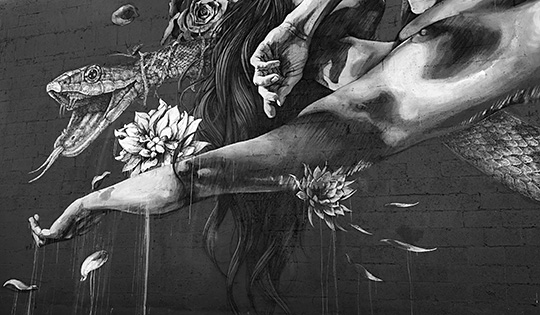 |
And ghosts. A swirling multitude of ghosts. Ghosts from everywhere, just like the living. That’s why I’m here. I am a gate maker and it’s my job to bring our ghosts back home.
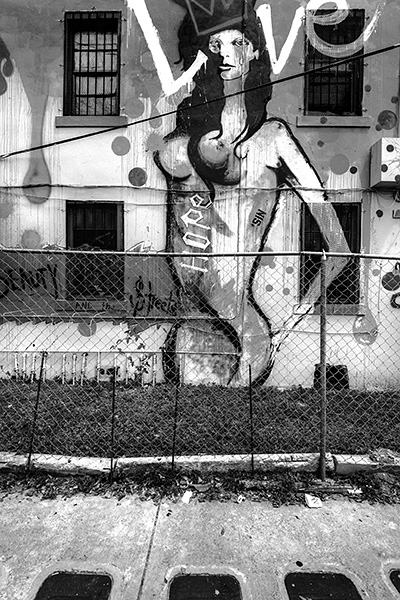 |
I come from Sumer, the land between two rivers. Mesopotamia, the Greeks came to call it, before the British declared it Iraq. It is a desert now, the color of burnt caramel. Once it was green, a long, long time ago, before the rivers changed course, before my people vanished into the dust. Before bombs and missiles. But Miami. That is a place as green and lush as the Garden of Eden. A place that stuns you with rampant color and skin and noise. So much motion. Here, the rhythm is different than the desert. Faster, more manic. My mind speeds up despite a century of training. My long black hair, usually smooth as water, warps and revolts from the moisture-laden air. My Sumerian skin turns bronze beneath the burning sun. Here, even in winter, the sun bites.
Miami. Magic City. Why do they call it that? I’m still not sure unless it refers to the spell it works on dreamers, those hungry souls who cross oceans, and mountains, and deserts to come here. Souls from all over the world, no doubt imagining a place of eternal light.
 |
Yet I hunt shades and lead them back to the Great Below and I can’t help but see the darkness here. It is my job to see things, the living and the dead, the thin places where the light leaks through or the darkness seeps in. I see it all, light and darkness everywhere, struggling for ascendancy; and in Florida, Wynwood straddles the divide as only a place marked by modern mystics can.
 |
When I first landed here, stepped off the bus with boots soft as butter, my woven bag across one shoulder, I was struck with a wave of heat, not dry like the desert but wet as a breath. An oppressive breath. Dominating like a slap to the face. In it, I could smell the fertile earth and the ocean despite miles of asphalt blanketing what once was a vast wetland teeming with mangroves and fish.
Now it is cars, cars, cars. Miami is a screaming metropolis, yet everywhere pockets of wilderness burst forth like some wild, virulent jungle vying for space, impatient to return. Nature chomps at the bit. She snorts and shakes her head in violent frustration. The encroachment is here. It is a constant battle to keep it back—the alligators, snakes, and iguanas. The rising waters, the tangled vines. In the desert, life fights tooth and nail just to exist, while here it can’t stop from being born.
Maybe that’s why the dead come.
I’ve been here thrice now and every time I step off that bus my impressions speed up. They flash at me like frames of a film—faster, faster, faster—assaulting me with images. Capricious rain, torrential storms, bougainvillea dripping like blood, rough waves, white moon, stars, emerald palms whipping in the wind, a dark glittering sea, an ocean of gray descending like a wave, black clouds sweeping in like ravens, a ravenous sun, rot steaming beneath a canopy of leaves, hot nights full of violence and cracked devils, lost girls with jagged blood, jittery gangsters with roaming eyes and hungry hands, tired men and women asleep on broken sidewalks beneath an underpass, beside an overflowing homeless shelter, white girls in the wrong neighborhood, black girls in the wrong neighborhood, over-flowing shopping carts teetering from the detritus of one’s life, a mislaid life, a drowned life in alcohol, insanity, crack and confusion, heartbroken hookers chewing at the air, their jaws working ceaselessly for that fix that never comes fast enough or lasts long enough, a quick suck or fuck for total oblivion. And I walk through it all, anonymous as a ghost, hidden beneath hoodies, armored in ancient ways and a relentless stride.
No one stops me. They let me go. They don’t know what I am, where I fall in the hierarchy of things, so they let me pass unscathed. For now. But still, I must be careful. Eyes open. Seeing everything. Bearing witness. Taking it all in. The geography, the empty spaces, the lines of color and turns of soul, until I find just the right place to write my own soul down, open the gates to Irkalla and lead our lost back home.
 |
I walk the streets, crisscrossing NW Second Ave. It’s changed since I was last here. More moneyed now despite Overtown still languishing half a mile over. Almost all the surfaces are painted or marked. Concrete walkways sprayed with stenciled phrases tell us MAYBE LOVE WAS MEANT TO SAVE US FROM OURSELVES or POST NO SELFIE. Dumpsters and streetlights have been tagged with paint or stickers and rainbow-colored, wide-eyed girls stare back at me from walls. A giant manatee takes flight while up the road a white, jeweled tiger looms above the sidewalk the way engraved lions once did in the great cities of Uruk or Nineveh.
Boutiques sell exorbitant hand-painted cowboy boots and imported textiles. Restaurants hawk shrimp tacos and mussels simmered in saffron. Hipsters hang out at Panther Coffee, Joey’s, Wynwood Café. A candy-red Lamborghini idles along the curb.
 |
Last time I was here, Wynwood was a dejected place of empty warehouses and shady drug deals. The post-WWII working class neighborhood had fallen into disrepair, abandoned as manufacturers fled for riper pastures. That’s when the taggers and bombers moved in. Graffiti came first, followed by street writers. All that smooth concrete, all those blank walls guarding abandoned lots, tempting itchy fingers and gallery rejects with wide open canvases free for anyone who had the courage to claim them.
Ten thousand gates with ten thousand keys.
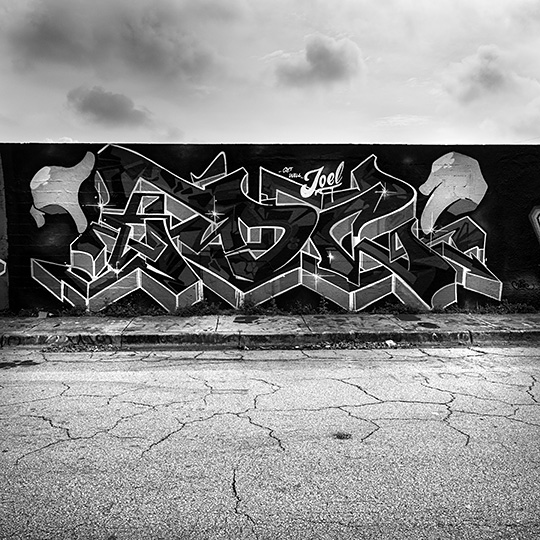 |
And why had I come here, so far from my home? I’ll tell you, even though you won’t believe it. It’s my job to write things down, especially those things no one will believe. But let me warn you, here’s where the story gets strange. As if portals and winged whales weren’t weird enough. There are so many different stories to tell and so many different ways to tell the same story. But I’m writing about Wynwood so I’ll keep my story brief.
My earliest name is Šerida, but you may call me Aya. Not a hundred pure Sumerians breathe in this world, and I am one of them. We follow the old ways. I have many titles: Daughter of the Seven Scribes, Scribe of the Seven Gates, Reed of Inanna, but my kind simply call me a Scribe of Irkalla. Cuneiform is my high art, though I am adept with pictures and pigments too. My favorite colors to work with are lapis lazuli and carnelian, and with the right spell I can cast gates that glow like the galaxy. I know all our mystical creatures and divine symbols by heart and can draw the Bull of Heaven blindfolded. I read Sumerian, Akkadian, Babylonian, and the stars though they’re hard to see in the city, and I’ve been trained in love and war as befits a servant of Inanna. All necessary skills for a scribe to open the gates and lead our dead back home.
Of course, this takes time, but we begin our journey early and live long.
I walk in the footsteps of Enheduanna, the world’s famous, first known scribe, daughter of King Sargon. The Lady, as I call her, was High Priestess to the moon god Sin, and yet she wrote hymns of unrivaled passion to her mistress Inanna, Queen of Heaven, Goddess of War. Only a dozen of our Lady’s tablets remain in the secret library, but I’ve read them all hundreds of times.
This is what she tells us:
Inanna went down to hell and let the spirits out. Hmm, perhaps I use the wrong word. Hell belongs to your world, not ours. Innana went down to Irkalla, the underworld, and let the dead out. Why she descended to the Great Below is a mystery, but I suspect she did it because she could. Why not? A king would go where he wanted, why not the Queen of Heaven?
She was granted passage through Irkalla’s seven gates only if she followed the gatekeeper’s instructions perfectly. At each gate she was ordered to remove an emblem of queenship, of power, until she stepped stark naked before her sister’s throne.
They say Inanna’s eyes, the color of lapis lazuli, glimmered in the dark. Her bare skin shone like the moon, like crushed pearl, and her long black hair falling upon her perfect breasts, gleamed like onyx, shifting in radiance as oil does upon water from black to darkest blue to deepest violet.
Inanna, Queen of Heaven, Morning Star, shone so bright she lit up the underworld like a torch, illuminating Irkalla, the Great Below, as if a meteorite had struck its depths.
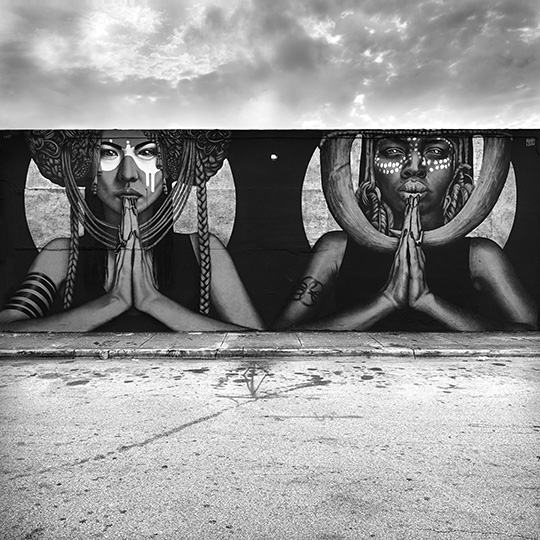 |
Needless to say, her sister Ereshkigal, Queen of the Underworld, was not pleased. She staked Inanna through the heart and hung her up for dead like a carcass of meat. A goat or a pig. For none who enter the Great Below shall ever rise again. It is the Land of No Return, and no one who enters, not even a god, is ever allowed to leave.
But Inanna didn’t play by the rules. She always was a wild one. Dragon slayer, King’s sword and lover all in one. She makes Pandora look like an innocent pup. Inanna could turn the whole world on its head. No wonder she was worshipped for four thousand years.
And yet, she did sometimes leave a wake of destruction in her path. And when after three days she returned to life and awoke in the Great Below, she led the dead back through the seven gates, out of Irkalla, and up to the Great Above just to spite her sister, I suspect. Our lovely Goddess of War unleashed her sister’s wards upon Sumer. Spirits, and shades, and demons too. We, Scribes of Irkalla, have done our best to round them up and lead them home, but some of them are slippery fellows. They glide right by our gates; they slip our noose. They wander far and wide until they’ve crossed continents and seas to wreak their havoc and whisper their rage into other people’s heads.
 |
And yet, despite being scamps, they’re desperate for hope, and I have seen them hovering about Wynwood’s walls as the sun descends, hungry and thirsty for the light they cannot reach.
We still hunt them. Not to hurt them. They’re our brethren and Ereshkigal’s wards. She holds us accountable. We simply mean to bring them home. They’re our ancestors, lost as they may be, and they belong with us. Ancient scribes from other lands hunt their own ghosts. When we find ours, we open the gates, all seven, and we lead the shades back in.
And so, as a daughter of the Seven Scribes, it is my duty to wander the world, studying the signs and tracking the dead. Shades roam far and wide, but they are drawn to thin places and drift to portals. They like heat and life and blood and feed off mayhem the way flies feast upon corpses. A shade wants to feel something, anything, and pain, even that of others, awakens them.
Hence Miami.
Mayhem flows through this city of magic the way power flows through my mistress Inanna. You can try to lock it up, contain and control it, but it’s no use. It seeps out of the earth like water. It ties itself in knots like vines.
Pain shines here. And heat and life and lust.
And so, the shades come and whisper to people. Stir them up. Get their blood boiling and send the weak ones on their murderous way.
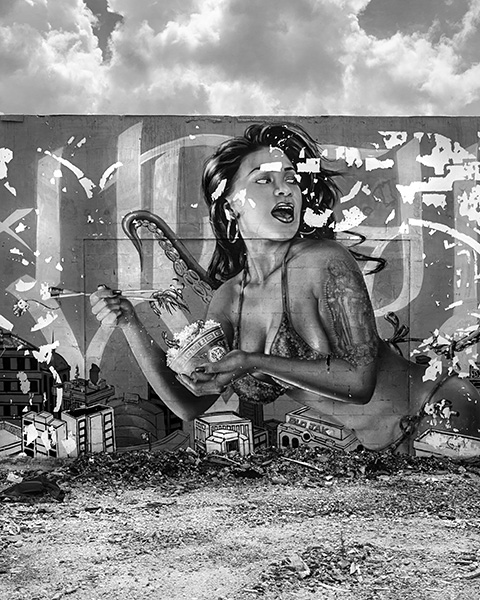 |
The thing is, street writers are drawn to portals and thin places too. They whisper to the living and the dead and stir them up. They scream. Museums and galleries, full of windows to another world, are cold and quiet, but street art burns beneath the sun, thrumming through the despair, thriving in broken places, and cherishing the forgotten. Decaying projects and fallen neighborhoods are its temples. Whores are welcome to come and worship. Killers too. And so, the modern street scribe plays with fire, laying down words and pictures like self-taught sorcerers wielding half-formed magic and drawing ghosts to them the way a naked woman ensnares a wild man.
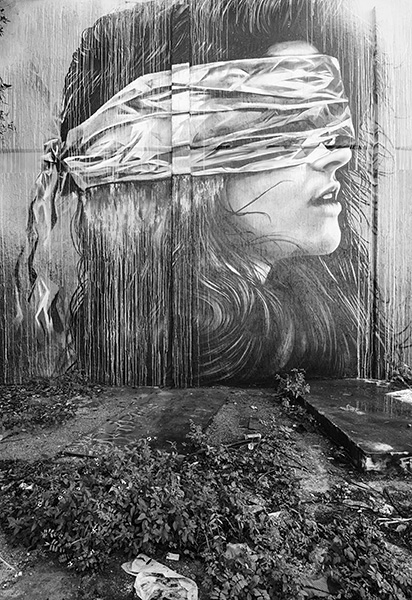 |
Wynwood has many gates and I am here to open seven more. But first I must find the right spot on the right night, when the stars align and our dead are close. And so, I wander the streets, searching the shade and the light, following the signs other scribes have left behind. Signs that lead to the thin places. A place where a woman or a man rips off the veil. A horned goddess, a striped shaman, stare straight back at you. A tusked beast with a long memory looks so deeply into your soul that you feel as if you might cry.
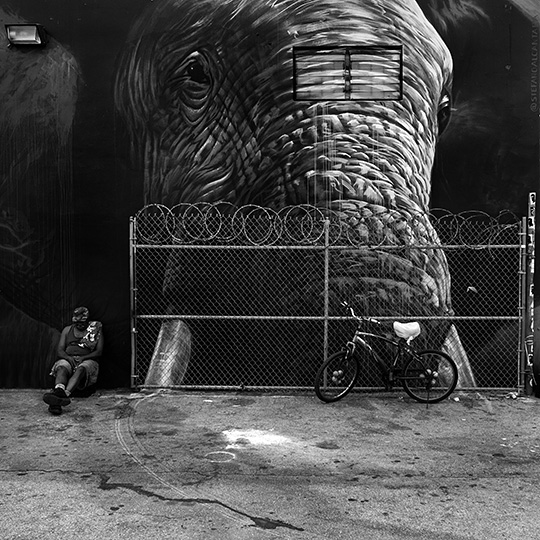 |
We are all gatekeepers of some kind or another.
There are ten thousand gates with ten thousand keys.
What gates are you opening? ![]()
Rob Haff’s photography has appeared in Black & White Magazine, Black + White Photography, Outdoor Photographer, Photographer’s Forum, and both solo and group exhibitions.